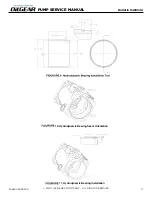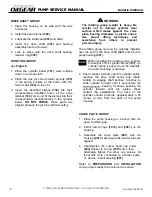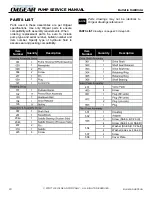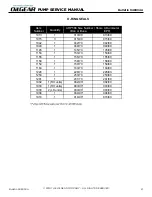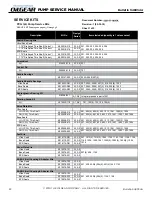
© 2019 THE OILGEAR COMPANY - ALL RIGHTS RESERVED
Bulletin 948034A
7
Bulletin 948034A
PUMP SERVICE MANUAL
Keep the fluid clean at all times to ensure long life
from your hydraulic system. Refer to the referenced
Oilgear Filtration Recommendations bulletin 90007
and Oilgear Contamination Evaluation Guide
Bulletin 90004. Oilgear recommends use of a filter
in the pressure or return line. Replace filter
element(s) when the filter condition indicator
reaches change area at normal fluid temperature.
Drain and thoroughly clean filter case. Use
replacement element(s) of same beta 10 ratio
(normally a ratio of 4 with hydraulic oils).
FLUID COOLING
FILTRATION
When the pump is operated continuously at the
rated pressure or frequently at peak load, auxiliary
cooling of the fluid may be necessary. Fluid
temperature should not exceed limits specified in
the referenced Oilgear Fluid Recommendations
Bulletin 90000.
AIR BREATHER
On most installations, an air breather is mounted
on top of fluid reservoir. It is important for the
breather to be the adequate size to allow air flow in
and out of reservoir as fluid level changes. Keep
the breather case filled to the “fluid level” mark.
About once every six months, remove cover, wash
screen in solvent and allow screen to dry, clean
and refill case to level mark and install screen.
Refer to the manufacturer's recommendations.
FLUID, FILLING AND STARTING
RECOMMENDATIONS
Refer to instruction plate on the unit, reservoir,
machine and/or reference, Fluid Recommendations
bulletin. Fire resistant fluids and phosphate ester
fluids can be used in accordance with fluid
manufacturer's recommendations.
1. Pump all fluid into reservoir through a clean
(beta 10 ratio of 4 or more) filter. Fill reservoir
to, but not above, “high level” mark on the sight
gauge.
2.
Remove case drain line and fill pump case
with hydraulic fluid.
3. Turn drive shaft a few times by hand with a
spanner wrench to make sure parts rotate.
Torque to turn drive shaft should be 9 to 24 ft•lb
(12 to 32 N•m).
With pump under “no load” or with pump control at
NEUTRAL:
4. Turn drive unit ON and OFF several times
before allowing pump to reach full speed. The
system can usually be filled by running the
pump and operating the control.
5. The fluid level in the reservoir should decrease.
Stop the pump.
DO NOT
allow the fluid level to
go beyond the “low level.” If the level reaches
“low level” mark, add fluid and repeat step.
With differential (cylinder) systems, the fluid
must not be above “high level” when the
ram is retracted or below “low level” when
extended. Bleed air from the system by
loosening connections or opening petcocks
at the highest point in the system. Close
connections or petcocks tightly when solid
stream of fluid appears.
CONSTRUCTION
See
Figure 3
.
A drive shaft
(301)
runs through the center line
of pump housing
(001)
and valve plate
(401)
with the pump cylinder barrel
(101)
splined to it.
A bearing
(306)
supports the outboard end of
the drive shaft and a bushing supports the
inboard end. (The bushing is part of valve plate
assembly.)
The pump cylinder barrel is carried in a
polymerous (journal type)
bearing
(
001
).
The valve plate
(401)
has two crescent shaped
ports.
The pumping piston/shoe assemblies
(102)
in
the cylinder barrel are held against a
swashblock
(201)
by a shoe retainer
(104)
.
The shoe retainer is held in position by the
fulcrum ball
(103)
which is forced outward by
the shoe retainer spring
(105)
.
The spring acts against the pump cylinder
barrel, forcing it against the valve plate while
also forcing the piston shoes against the
swashblock.
The semi-cylindrical shaped swashblock limits
the piston stroke and can be swiveled in arc
shaped saddle bearings
(204).
The swashblock is swiveled by a control
(included in referenced material). Refer to
PRINCIPLE OF OPERATION
.
NOTE

















